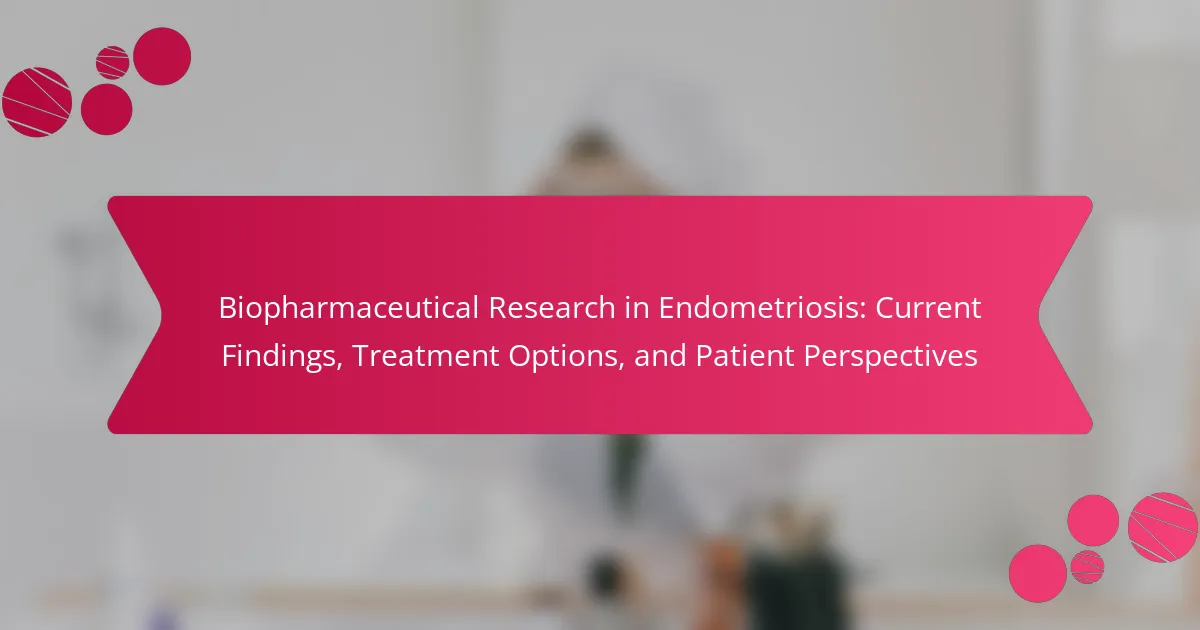Biopharmaceutical research is transforming treatment options for endometriosis, addressing unique patient challenges. Current findings highlight novel therapies and the importance of personalized care. Treatment options range from hormonal therapies to surgical interventions, with a focus on patient perspectives shaping research priorities. Understanding these developments can empower patients to advocate for their treatment needs effectively.

What are the latest advancements in biopharmaceutical research for endometriosis treatment?
Recent advancements in biopharmaceutical research for endometriosis treatment include novel drug candidates and innovative therapeutic approaches. Researchers are focusing on targeted therapies, such as hormonal treatments that modulate the immune response, and biologics that inhibit inflammatory pathways. Clinical trials are exploring the efficacy of these treatments, with promising results indicating improved symptom management. Additionally, patient perspectives are increasingly influencing research priorities, emphasizing the need for personalized treatment options.
How do these advancements improve patient outcomes?
Advancements in biopharmaceutical research significantly enhance patient outcomes in endometriosis. Improved treatment options lead to better symptom management and quality of life. For instance, novel therapies target specific biological pathways, reducing pain and improving fertility rates. Patient perspectives indicate increased satisfaction with personalized treatment plans, reflecting greater engagement in their care. Enhanced understanding of disease mechanisms contributes to more effective interventions, ultimately fostering a supportive environment for patients.
Which biopharmaceuticals are currently in clinical trials?
Several biopharmaceuticals are currently in clinical trials for endometriosis treatment. Notable candidates include Elagolix, a GnRH antagonist, and Raloxifene, a selective estrogen receptor modulator. These drugs aim to alleviate pain and reduce the size of endometriotic lesions. Other investigational therapies include monoclonal antibodies targeting inflammatory pathways and novel hormonal treatments. Ongoing trials assess their efficacy and safety profiles, offering hope for improved management of endometriosis.

What are the most common treatment options available for endometriosis?
The most common treatment options for endometriosis include hormonal therapies, pain management, and surgical interventions. Hormonal therapies, such as birth control pills and GnRH agonists, help reduce inflammation and suppress menstruation. Pain management involves nonsteroidal anti-inflammatory drugs (NSAIDs) to alleviate discomfort. Surgical options range from laparoscopic excision of endometrial tissue to hysterectomy in severe cases. Each treatment varies in effectiveness and side effects, requiring personalized approaches based on patient needs and perspectives.
How do hormonal therapies compare to surgical options?
Hormonal therapies and surgical options for endometriosis have distinct advantages and drawbacks. Hormonal therapies, such as birth control pills and GnRH agonists, offer non-invasive management and can reduce symptoms effectively. However, they may not eliminate endometriosis completely. Surgical options, including laparoscopic excision, provide the potential for complete removal of endometriosis lesions but involve recovery time and risks associated with surgery.
| Comparison Attribute | Hormonal Therapies | Surgical Options |
|—————————|—————————–|—————————–|
| Invasiveness | Non-invasive | Invasive |
| Symptom Relief | Effective | Potentially complete |
| Recovery Time | Minimal | Significant |
| Risks | Fewer | Surgical complications |
| Duration of Treatment | Ongoing | One-time procedure |
| Cost | Generally lower | Often higher |
What role do pain management strategies play in treatment?
Pain management strategies are essential in treating endometriosis as they enhance quality of life and alleviate symptoms. These strategies include pharmacological approaches, such as non-steroidal anti-inflammatory drugs and hormonal therapies, which target pain relief. Non-pharmacological methods, like physical therapy and cognitive-behavioral therapy, also play a significant role. According to recent studies, effective pain management can lead to improved patient satisfaction and adherence to treatment plans. Integrating these strategies into comprehensive care can address both physical and emotional aspects of endometriosis, ultimately fostering better health outcomes.

What unique challenges do patients face in managing endometriosis?
Patients managing endometriosis face unique challenges such as chronic pain and emotional distress. These difficulties often stem from the condition’s unpredictable nature and its impact on daily life. Many patients report a lack of understanding from healthcare providers, which can lead to inadequate treatment options. The stigma surrounding menstrual health may also prevent open discussions about symptoms, delaying diagnosis and management. Additionally, navigating available biopharmaceutical treatments can be overwhelming due to varying efficacy and potential side effects.
How does the severity of symptoms impact daily life?
The severity of symptoms significantly impacts daily life for individuals with endometriosis. Severe pain can hinder daily activities, affecting work, social interactions, and mental health. Patients often report reduced productivity and increased absenteeism due to debilitating symptoms. Additionally, chronic fatigue and emotional distress are common, leading to a diminished quality of life. Access to effective biopharmaceutical treatments can mitigate these challenges, improving overall well-being and functionality.
What psychological effects are commonly reported by patients?
Patients with endometriosis commonly report psychological effects such as anxiety, depression, and stress. These emotional challenges often stem from chronic pain and the impact of the condition on daily life. Research indicates that around 50% of women with endometriosis experience significant psychological distress. The stigma surrounding menstrual health can exacerbate feelings of isolation and frustration. Addressing these psychological effects is crucial for holistic treatment approaches.

How do patient perspectives influence treatment decisions?
Patient perspectives significantly influence treatment decisions in biopharmaceutical research for endometriosis. Patients’ experiences shape the understanding of symptoms, treatment efficacy, and quality of life. Involving patients in treatment discussions ensures their preferences and values are prioritized, leading to more personalized care. Research shows that when patients express their perspectives, it can lead to improved adherence to treatment and better health outcomes. Furthermore, incorporating patient feedback can guide the development of new therapies, aligning them with real-world needs.
Which factors do patients prioritize when choosing a treatment?
Patients prioritize efficacy, safety, side effects, and treatment duration when choosing a treatment for endometriosis. These factors significantly influence their decision-making process.
1. Efficacy: Patients seek treatments that effectively alleviate symptoms and improve quality of life.
2. Safety: The safety profile of a treatment is crucial, as patients want to avoid harmful side effects.
3. Side Effects: Minimizing adverse effects is a priority, as they can impact daily life and treatment adherence.
4. Treatment Duration: Patients prefer options that require less time commitment while still being effective.
Understanding these priorities helps healthcare providers tailor treatment plans to meet patient needs.
How can healthcare providers better support patient needs?
Healthcare providers can better support patient needs by prioritizing personalized treatment plans, improving communication, and actively involving patients in their care decisions.
Current biopharmaceutical research indicates that tailored therapies for endometriosis can significantly enhance patient outcomes. For example, understanding individual responses to treatments allows providers to adjust medications based on efficacy and side effects.
Additionally, fostering open dialogue between healthcare professionals and patients enables a better understanding of symptoms and treatment preferences. This approach can lead to more effective management strategies.
Lastly, integrating patient perspectives into clinical trials can provide valuable insights, ensuring that the research aligns with real-world needs and experiences.

What are the emerging trends in patient-reported outcomes for endometriosis?
Emerging trends in patient-reported outcomes for endometriosis emphasize the importance of personalized treatment approaches and real-time data collection. Recent studies highlight the integration of digital health tools, enabling patients to report symptoms and treatment responses more frequently. This shift enhances the understanding of individual experiences and treatment efficacy. Moreover, there is a growing focus on the psychosocial impacts of endometriosis, with patient perspectives increasingly shaping research priorities and clinical guidelines. Enhanced patient engagement is crucial for improving overall care and outcomes.
How are patient experiences shaping future research directions?
Patient experiences are increasingly influencing biopharmaceutical research directions in endometriosis. Researchers are prioritizing patient-reported outcomes to develop treatments that align with patients’ needs and preferences. This shift is evident in the focus on personalized medicine approaches, which consider individual responses to therapies. Additionally, patient advocacy groups are driving awareness, leading to more funding and research initiatives targeting specific symptoms and quality of life improvements. Integrating patient feedback into clinical trials enhances relevance and efficacy of new treatments, ensuring they address real-world challenges faced by those with endometriosis.
What metrics are being used to assess treatment efficacy from a patient viewpoint?
Patient viewpoints on treatment efficacy in endometriosis are assessed using metrics like symptom relief, quality of life, treatment adherence, and side effects. These metrics provide insight into the effectiveness of biopharmaceutical interventions.
| Metric | Description | Importance |
|———————–|———————————————|———————————|
| Symptom Relief | Reduction in pain and other symptoms | Direct measure of treatment success |
| Quality of Life | Overall well-being and daily functioning | Reflects holistic patient experience |
| Treatment Adherence | Consistency in following treatment plans | Indicates patient engagement and trust |
| Side Effects | Frequency and severity of adverse effects | Essential for evaluating treatment safety |

What are the implications of biopharmaceutical research on healthcare policies for endometriosis?
Biopharmaceutical research significantly influences healthcare policies for endometriosis by driving innovation in treatment options. Current findings highlight the need for policy adjustments to ensure access to advanced therapies. As biopharmaceuticals evolve, policies must adapt to incorporate new evidence-based treatments that improve patient outcomes. This shift encourages funding for research and supports the integration of patient perspectives in policy-making. Enhanced collaboration between researchers, healthcare providers, and policymakers will facilitate the development of comprehensive care strategies for endometriosis.
How can advocacy groups influence research funding and awareness?
Advocacy groups can significantly influence research funding and awareness by mobilizing public support and lobbying for policy changes. They raise awareness about endometriosis, highlighting its impact on patients, which can attract funding from government and private sectors. For instance, they often share personal stories and data that emphasize the need for more research, driving both public interest and funding initiatives. Additionally, collaboration with researchers can lead to targeted studies that align with patient needs, further enhancing the relevance and application of research findings.
What role do regulatory bodies play in the approval of new treatments?
Regulatory bodies ensure the safety and efficacy of new treatments through rigorous evaluation processes. They assess clinical trial data, review manufacturing practices, and monitor post-market safety. This oversight fosters patient trust and promotes innovation in biopharmaceutical research for endometriosis. For example, the FDA requires comprehensive data before granting approval, which can take several years. By setting high standards, regulatory bodies protect patients while facilitating access to effective therapies.

What practical strategies can patients use to advocate for their treatment needs?
Patients can advocate for their treatment needs by being informed and proactive. First, they should research current biopharmaceutical findings related to endometriosis. Understanding the latest treatment options empowers patients to discuss their preferences with healthcare providers. Keeping a symptom diary can help articulate experiences and needs during medical appointments. Additionally, joining support groups offers insights into shared experiences and effective advocacy strategies. Lastly, patients should not hesitate to ask questions and seek second opinions to ensure their treatment aligns with their needs.
How can patients effectively communicate with healthcare providers?
Patients can effectively communicate with healthcare providers by being prepared, asking questions, and sharing their experiences. Clear communication fosters better understanding and improves treatment outcomes.
1. Prepare a list of symptoms and concerns before appointments.
2. Ask specific questions about treatment options and side effects.
3. Share personal experiences and how symptoms affect daily life.
4. Clarify any medical terms or instructions given by the provider.
5. Follow up on previous discussions or treatments to ensure continuity.
6. Utilize patient portals or communication tools for ongoing dialogue.
What resources are available for patients seeking support and information?
Patients seeking support and information on endometriosis can access various resources. Organizations such as the Endometriosis Foundation of America and the World Endometriosis Society offer educational materials and support networks. Online platforms provide forums for patient interaction and shared experiences. Healthcare providers often recommend local support groups and counseling services tailored for endometriosis patients. Additionally, academic journals and research publications contain the latest findings and treatment options, enhancing patient understanding.
